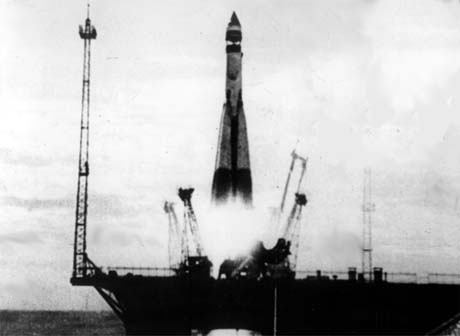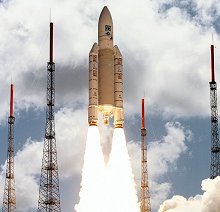Europe's history in space:Russia, France, UK, Italy and Others
EUROPE IN SPACE HISTORY ROCKETS SPACECRAFT ASTRONAUTS SPACE STATION ASTRONOMY EUROPE
Nations of Europe were the earliest pioneers of spaceflight, along with the United States.
Russia. Kapustin Yar Cosmodrome was the Soviet Union's first rocket development center. Its first launch was in 1947. During the early years, Kapustin Yar tested V2 missiles captured from the Germans at the end of World War 2. The site also saw sounding rocket launches in the early years carrying dogs and other animals up to altitudes as high as 300 miles. Kapustin Yar Cosmodrome is known as the Volgograd Station to those who work there.
1957 Novosti photo of Sputnik One
riding Old Number Seven
The first orbital launch from Kapustin Yar was Cosmos-1 in 1962. Seventy space launches to orbit were carried out by 1980, mostly small Cosmos science satellites. The USSR switched its space launches to Plesetsk leaving Kapustin Yar to send up only occasional missions, usually for radar calibration. There have been no launches to orbit from Kapustin Yar since 1987. Space launches from Kapustin Yar totaled 83. Today there are some missile testing activities as well as Cosmos suborbital launches.
In 1957, the first of several pads at Plesetsk Cosmodrome for launches of the old R7 or A-class missiles-rockets were constructed in support of the USSR's then-infant intercontinental ballistic missile (ICBM) program. The pads and ICBM rockets moved to active duty in 1960. For a long time, Plesetsk Cosmodrome was the world's busiest spaceport. However, it eventually was overtaken by Baikonur as launch campaigns were transferred to newer space boosters at Tyuratam. Today, there are launch pads -- for Cosmos, Soyuz/Molniya Tsyklon and Zenit space boosters at Plesetsk.
On October 4, 1957, the U.S.S.R. became the first nation to loft an artificial moon to orbit above Earth. The satellite was Sputnik-1. It rode atop a rocket called Old Number Seven in a launch from Baikonur Cosmodrome in Kazakhstan in central Asia.
Missile and rocket launches had begun back in the 1950s in the Baikonur/Tyuratam area of Kazakhstan. The launch pad from which Sputnik 1 and Yuri Gagarin were launched was constructed in 1955. In 1957, the launch site was said to be near Tyuratam in Kazakhstan, about 230 miles southwest of Baikonur. However, the Soviet Union government tried to hide the location by reporting its latitude and longitude as the same as that for the town of Baikonur. Kazakhstan finally renamed the launch site after the closure of Tyuratam in 1992. However, the global space community still refers to it as Baikonur Cosmodrome.
France. On November 26, 1965, France became the third nation to launch an artificial moon to orbit above Earth. The satellite was Asterix-1. It rode atop a rocket called Diamant in a launch from Hammaguir, Algeria, North Africa.
Great Britain. On October 28, 1971, Great Britain became the sixth nation to launch an artificial moon to orbit above Earth. The satellite was Black Knight-1. It rode atop a rocket called Black Arrow in a launch from Woomera, Australia.
Ariane rocket
Europe. On December 24, 1979, European Space Agency became the seventh to launch an artificial moon to orbit above Earth. The satellite was named CAT. It rode atop a rocket called Ariane in a launch from Kourou, French Guiana, South America.
Italy. Italy's San Marco Range actually is a pair of platforms in Formosa Bay three miles off the coast of Kenya. The San Marco platform is the launch pad. Santa Rita platform holds the firing control blockhouse. The range started firing rockets in 1966. Eight satellites were boosted to space from there by 1976. Italy used the offshore platform for another launch in 1988.
Spain. Spain conducts space research at Torrejon Air Base. However, launches to space are not made from the site.
More information on the European Space Agency
| Europe in Space | | | Search STO | | | STO cover | | | Questions | | | Feedback | | | © 2003 Space Today Online |

